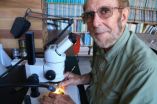(Press-News.org) Most of North America's megafauna — mastodons, short-faced bears, giant ground sloths, saber-toothed cats and American camels and horses — disappeared close to 13,000 years ago at the end of the Pleistocene period. The cause of this massive extinction has long been debated by scientists who, until recently, could only speculate as to why.
A group of scientists, including UC Santa Barbara's James Kennett, professor emeritus in the Department of Earth Science, posited that a comet collision with Earth played a major role in the extinction. Their hypothesis suggests that a cosmic-impact event precipitated the Younger Dryas period of global cooling close to 12,800 years ago. This cosmic impact caused abrupt environmental stress and degradation that contributed to the extinction of most large animal species then inhabiting the Americas. According to Kennett, the catastrophic impact and the subsequent climate change also led to the disappearance of the prehistoric Clovis culture, known for its big game hunting, and to human population decline.
In a new study published this week in the Journal of Geology, Kennett and an international group of scientists have focused on the character and distribution of nanodiamonds, one type of material produced during such an extraterrestrial collision. The researchers found an abundance of these tiny diamonds distributed over 50 million square kilometers across the Northern Hemisphere at the Younger Dryas boundary (YDB). This thin, carbon-rich layer is often visible as a thin black line a few meters below the surface.
Kennett and investigators from 21 universities in six countries investigated nanodiamonds at 32 sites in 11 countries across North America, Europe and the Middle East. Two of the sites are just across the Santa Barbara Channel from UCSB: one at Arlington Canyon on Santa Rosa Island, the other at Daisy Cave on San Miguel Island.
"We conclusively have identified a thin layer over three continents, particularly in North America and Western Europe, that contain a rich assemblage of nanodiamonds, the production of which can be explained only by cosmic impact," Kennett said. "We have also found YDB glassy and metallic materials formed at temperatures in excess of 2200 degrees Celsius, which could not have resulted from wildfires, volcanism or meteoritic flux, but only from cosmic impact."
The team found that the YDB layer also contained larger than normal amounts of cosmic impact spherules, high-temperature melt-glass, grapelike soot clusters, charcoal, carbon spherules, osmium, platinum and other materials. But in this paper the researchers focused their multi-analytical approach exclusively on nanodiamonds, which were found in several forms, including cubic (the form of diamonds used in jewelry) and hexagonal crystals.
"Different types of diamonds are found in the YDB assemblages because they are produced as a result of large variations in temperature, pressure and oxygen levels associated with the chaos of an impact," Kennett explained. "These are exotic conditions that came together to produce the diamonds from terrestrial carbon; the diamonds did not arrive with the incoming meteorite or comet."
Based on multiple analytical procedures, the researchers determined that the majority of the materials in the YDB samples are nanodiamonds and not some other kinds of minerals. The analysis showed that the nanodiamonds consistently occur in the YDB layer over broad areas.
"There is no known limit to the YDB strewnfield which currently covers more than 10 percent of the planet, indicating that the YDB event was a major cosmic impact," Kennett said. "The nanodiamond datum recognized in this study gives scientists a snapshot of a moment in time called an isochron."
To date, scientists know of only two layers in which more than one identification of nanodiamonds has been found: the YDB 12,800 years ago and the well-known Cretaceous-Tertiary boundary 65 million years ago, which is marked by the mass extinction of the dinosaurs, ammonites and many other groups.
"The evidence we present settles the debate about the existence of abundant YDB nanodiamonds," Kennett said. "Our hypothesis challenges some existing paradigms within several disciplines, including impact dynamics, archaeology, paleontology and paleoceanography/paleoclimatology, all affected by this relatively recent cosmic impact."
INFORMATION: END
Nanodiamonds are forever
A UCSB professor's research examines 13,000-year-old nanodiamonds from multiple locations across 3 continents
2014-08-27
ELSE PRESS RELEASES FROM THIS DATE:
IU study: Social class makes a difference in how children tackle classroom problems
2014-08-27
BLOOMINGTON, Ind. -- An Indiana University study has found that social class can account for differences in how parents coach their children to manage classroom challenges. Such differences can affect a child's education by reproducing inequalities in the classroom.
"Parents have different beliefs on how to deal with challenges in the classroom," said Jessica McCrory Calarco, assistant professor in IU Bloomington's Department of Sociology in the College of Arts and Sciences. "Middle-class parents tell their children to reach out to the teacher and ask questions. Working-class ...
Wolves susceptible to yawn contagion
2014-08-27
Wolves may be susceptible to yawn contagion, according to a study published August 27, 2014 in the open-access journal PLOS ONE by Teresa Romero from The University of Tokyo, Japan, and colleagues.
Researchers suggest that contagious yawning may be linked to human capacity for empathy, but little evidence apart from studies on primates, exists that links contagious yawning to empathy in other animals. Recently, researchers have documented domestic dogs demonstrating contagious yawning when exposed to human yawns in a scientific setting, but it is unclear whether this ...
Stone-tipped spears more damaging than sharpened wooden spears
2014-08-27
Experimental comparison may show that stone-tipped spears do not penetrate as deep, but may still cause more damage, than sharpened wooden spears, according to a study published August 27, 2014 in the open-access journal PLOS ONE by Jayne Wilkins from Arizona State University and colleagues.
The creation of stone-tipped weapons (wooden shaft + binding materials + stone point) by our ancestors ~500,000 years ago points to the development of new cognitive and social learning at the time. The development may have provided an advantage over simpler hunting methods, such as ...
Bronze Age wine cellar found
2014-08-27
A Bronze Age palace excavation reveals an ancient wine cellar, according to a study published August 27, 2014 in the open-access journal PLOS ONE by Andrew Koh from Brandeis University and colleagues.
Wine production, distribution, and consumption are thought to have played a role in the lives of those living in the Mediterranean and Near East during the Middle Bronze Age (1900-1600 BC), but little archaeological evidence about Bronze Age wine is available to support art and documentation about the role wine played during this period. During a 2013 excavation of the Middle ...
Xenon exposure shown to erase traumatic memories
2014-08-27
Belmont, MA — McLean Hospital researchers are reporting that xenon gas, used in humans for anesthesia and diagnostic imaging, has the potential to be a treatment for post-traumatic stress disorder (PTSD) and other memory-related disorders.
"In our study, we found that xenon gas has the capability of reducing memories of traumatic events," said Edward G. Meloni, PhD, assistant psychologist at McLean Hospital and an assistant professor of Psychiatry at Harvard Medical School. "It's an exciting breakthrough, as this has the potential to be a new treatment for individuals ...
New drug promises relief for inflammatory pain, Stanford scientists say
2014-08-27
Pain from inflammation sidelines thousands of Americans each year. Many face a tough choice: deal with the pain, take a potentially addictive opioid or use a nonsteroidal anti-inflammatory drug that may increase risk for cardiovascular disease or gastrointestinal bleeding.
Now, researchers at the Stanford University School of Medicine have discovered a compound thought to be nonaddictive and safe for the heart and gastrointestinal system that reduces inflammatory pain in mice and rats. They call the compound Alda-1.
"Finding a new pain medication is important because ...
Stone-tipped spears lethal, may indicate early cognitive and social skills
2014-08-27
Attaching a stone tip on to a wooden spear shaft was a significant innovation for early modern humans living around 500,000 years ago. However, it was also a costly behavior in terms of time and effort to collect, prepare and assemble the spear. Stone tips break more frequently than wooden spears, requiring more frequent replacement and upkeep, and the fragility of a broken point could necessitate multiple thrusts to an angry animal. So, why did early hunters begin to use stone-tipped spears?
To learn if there was a "wounding" advantage between using a wooden spear or ...
Orphaned children can do just as well in institutions
2014-08-27
DURHAM, N.C. -- The removal of institutions or group homes will not lead to better child well-being and could even worsen outcomes for some orphaned and separated children, according to new findings from a three-year study across five low- and middle-income countries.
Children in institutions are as healthy and, in some ways, healthier than those in family-based care, according to the study, which was led by Kathryn Whetten, a Duke professor of public policy and director of the Center for Health Policy and Inequalities Research (CHPIR).
In the largest and most geographically ...
Self-deceived individuals deceive others better
2014-08-27
Over confident people can fool others into believing they are more talented than they actually are, a study has found.
These 'self-deceived' individuals could be more likely to get promotions and reach influential positions in banks and other organisations. And these people are more likely to overestimate other people's abilities and take greater risks, possibly creating problems for their organisations.
The study by researchers from Newcastle University and the University of Exeter, has also found that those who are under confident in their own abilities are viewed ...
Brain networks 'hyper-connected' in young adults who had depression
2014-08-27
Depression may be better predicted and understood now that University of Illinois at Chicago researchers have discovered that young adults who previously experienced the mental illness have hyper-connected emotional and cognitive networks in the brain.
UIC researchers used functional magnetic resonance imaging to examine the brain connectivity of young adults ages 18 to 23 while they were in a resting state. Thirty unmedicated young adults who had previously experienced depression and 23 healthy controls were used in the study, which has been published online in the journal ...
LAST 30 PRESS RELEASES:
Geometry shapes life
A CRISPR screen reveals many previously unrecognized genes required for brain development and a new neurodevelopmental disorder
Hot flush treatment has anti-breast cancer activity, study finds
Securing AI systems against growing cybersecurity threats
Longest observation of an active solar region
Why nail-biting, procrastination and other self-sabotaging behaviors are rooted in survival instincts
Regional variations in mechanical properties of porcine leptomeninges
Artificial empathy in therapy and healthcare: advancements in interpersonal interaction technologies
Why some brains switch gears more efficiently than others
UVA’s Jundong Li wins ICDM’S 2025 Tao Li Award for data mining, machine learning
UVA’s low-power, high-performance computer power player Mircea Stan earns National Academy of Inventors fellowship
Not playing by the rules: USU researcher explores filamentous algae dynamics in rivers
Do our body clocks influence our risk of dementia?
Anthropologists offer new evidence of bipedalism in long-debated fossil discovery
Safer receipt paper from wood
Dosage-sensitive genes suggest no whole-genome duplications in ancestral angiosperm
First ancient human herpesvirus genomes document their deep history with humans
Why Some Bacteria Survive Antibiotics and How to Stop Them - New study reveals that bacteria can survive antibiotic treatment through two fundamentally different “shutdown modes”
UCLA study links scar healing to dangerous placenta condition
CHANGE-seq-BE finds off-target changes in the genome from base editors
The Journal of Nuclear Medicine Ahead-of-Print Tip Sheet: January 2, 2026
Delayed or absent first dose of measles, mumps, and rubella vaccination
Trends in US preterm birth rates by household income and race and ethnicity
Study identifies potential biomarker linked to progression and brain inflammation in multiple sclerosis
Many mothers in Norway do not show up for postnatal check-ups
Researchers want to find out why quick clay is so unstable
Superradiant spins show teamwork at the quantum scale
Cleveland Clinic Research links tumor bacteria to immunotherapy resistance in head and neck cancer
First Editorial of 2026: Resisting AI slop
Joint ground- and space-based observations reveal Saturn-mass rogue planet
[Press-News.org] Nanodiamonds are foreverA UCSB professor's research examines 13,000-year-old nanodiamonds from multiple locations across 3 continents







